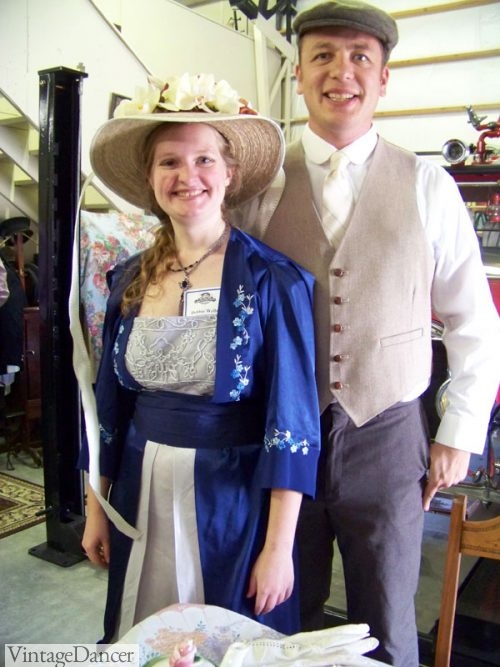
My titanic inspired “swim dress”
I adore Rose’s dresses from the movie Titanic. The Edwardian fashion era was all about showing off your wealth. Dresses were made of fine silk, lace, and hand-beaded chiffon. To make a dress with these materials today would be a big expense. Luckily, it only takes a little creativity to make a simple Titanic dress for under $20.
Titanic movie fans, historical fashion reenactors, and costumers for the Titanic musical will all benefit from these instructions. This quick how-to guide will walk you through each step so that you can be ready for your “Titanic” themed event in no time.
Things You Will Need
- Dress
- Robe
- Sash
- Safety Pins
- Accessories (optional)
Shopping: You may be surprised to find that you already have some or all of the items you need in your closet already. For the remainder of the pieces, I recommend going to your nearest thrift store or vintage clothing store. If you don’t have a thrift store nearby, you can probably go to a department store (Kohls, Target, Macy’s, JC Penny’s, Amazon, etc.) and find all the items in one place. Finally, a trip to a fabric and craft store may be needed for the sash.
Putting Together the Titanic Dress
Here is my OLD (2011) video of the process:
Step 1: The Underdress

Examples of good underdresses- long skirts, empire waist, modest neckline
Look for a long formal dress, maxi dress, or basic slip dress with a straight shape to the skirt. You can choose whatever color you like, although I would avoid very bright colors if you want your dress to look authentic to the era. The top of the dress should have an empire waist with a horizontal bust line that starts midway between your chest and collarbone. Showing off cleavage was not acceptable at the time (even though you see a lot of cleavage in the Titanic movie). Avoid V-necklines or low scoop necklines at all cost. Modesty is very important in the Edwardian era.
Sleeves can be any length. Traditionally, sleeves were either long or short and snug to the skin. However, since we’ll be covering up the sleeves with a robe, it really doesn’t matter what sleeves come with the dress. Sleeveless dresses are fine, too.
I do not recommended fabric that is metallic or glittery because these are too modern for the correct look. Chiffon, lace, rayon, or polyester blends are the best fabrics. If you find a fabric with a pattern or texture, that is ok, just be sure to choose a plain overcoat to avoid clashing patterns.
There are a few vintage inspired dress brands that are perfect for the Edwardian/ Titanic era. Nataya is my favorite. Have look at them here. Another source for white dresses are Victorian style nightgowns.
Step 2: The Overdress or Robe
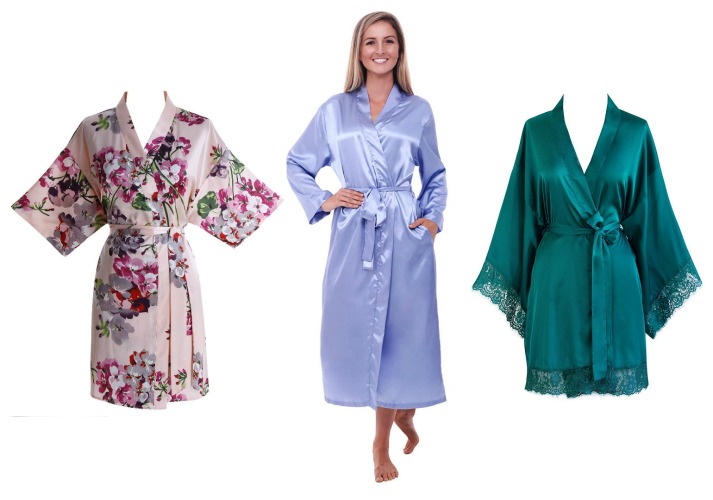
Short or long, floral or solid satin kimono robes make great overdresses. Shop on Amazon for Kimono robes.
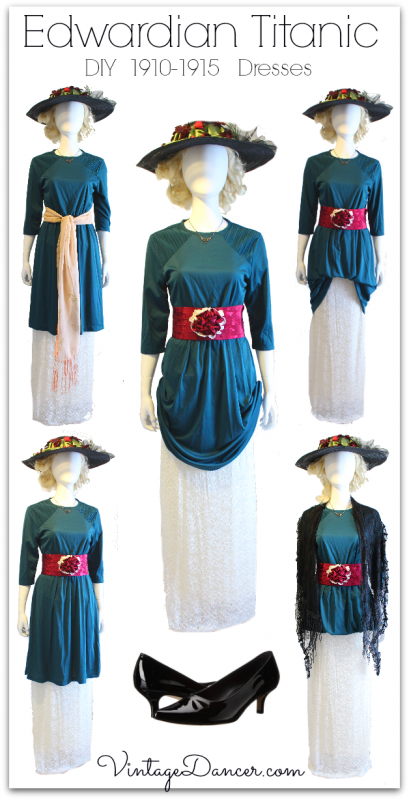
Titanic costume varieties by gathering the over dress in several ways.
Next, walk over to the nightgown/lingerie section of the store and look for an unlined silk or satin night robe. A light see-through lace or chiffon robe is also a nice option. Robes can hang down to your thigh or be full length. Find the smallest one that fits, otherwise you may need to do some alterations. I like to choose colors that contrast with the dress. For example a dark coat with a light dress, a light coat with a dark dress, a patterned robe with a plain dress, etc.
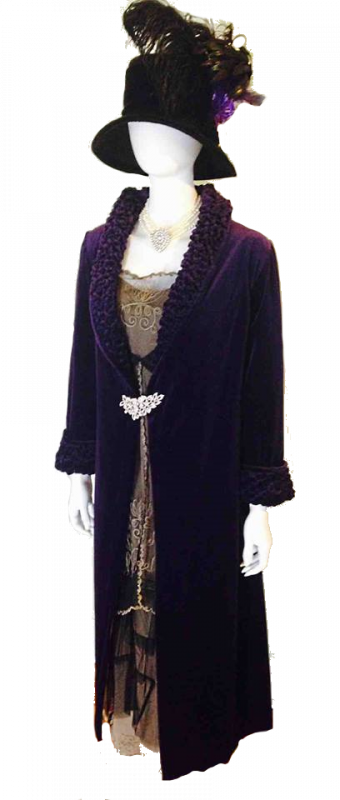
DIY velvet coat made from a bathrobe, over a Nataya dress, paired with DIY hat with feather plumes.
The current trend for Kimono robes (a throwback to the more recent ’70s) is perfect for 1910 to early 1920s styles. Silk, satin, or chiffon type materials are best for this era. Beaded Kimono coats are late teens to early ’20s style. Shop Kimono coats and wraps here or here.
You could also layer on another tea length dress. I use this technique in this article on DIY Titanic costumes. Find a modest solid or print dress that comes down to mid-thigh or knee and layer it over your underdress.
A final option is a heavy velvet robe with a shawl collar, seen above. I happened to find one in a thrift store that looked perfect for the Edwardian era. I layered it over a nice dress and clipped it with a fancy brooch. Voila! Be warned, heavy robes in summer heat do not mix. : (
The Sash Band
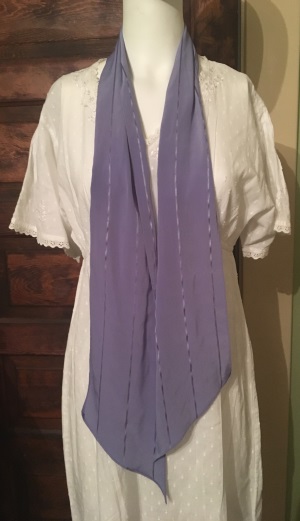
A simple light scarf makes a nice sash band
For the sash, you use a long silk or satin scarf. Another option is to buy wide satin ribbon or a strip of fabric long enough to wrap around your body and tie. The ideal width is 4-6 inches or wider if you fold it 2-3 times. Many Edwardian dresses had sashes that tied at the back and then hung down to the floor. If you want this look, you will need a lot of ribbon or fabric. You could also wrap and tuck the sash around to create an obi belt. This was the inspiration for many dresses of this era. Most obis are stiff, so use a piece of cardboard or craft foam to wrap your sash around to create a stiffer waistband.
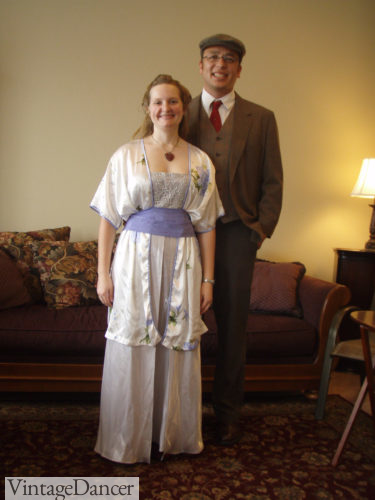
DIY Titanic Tea Dress with Long Gown, Light Floral Silk Robe, and a Silk Sash
The sash color is the boldest of the three garments. Try bright pink against navy/silver, yellow against pink/blue, or green against yellow/white. You could also go tonal in color meaning all garments are various shades of the same color. This makes a sophisticated look for mature women. Bright colors would be worn by young women looking to attract a partner.
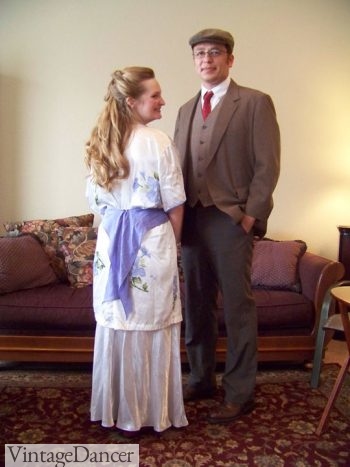
My sash is pinned and hangs down the back. A pretty effect.
Putting it All Together
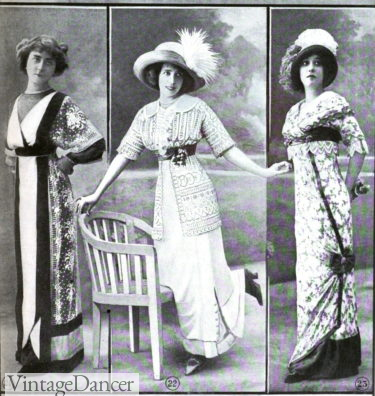
1911 Layered and sashes dresses
Slip on the dress, place the robe over the dress, and tie the sash just under the breast and around your ribs. If your fabric is slippery, you may need to pin the sash to the dress from the inside (to hide the pins) as well as in the back to keep the shape of the sash more like a wide band. Now adjust the robe’s front panels to leave an opening wide enough to show off your neck and upper chest.
Alterations and Additions
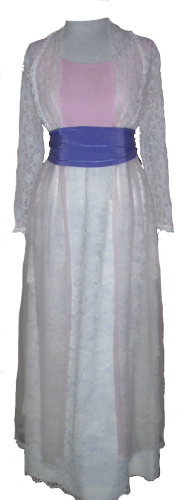
Titanic “Swim” Dress
Be sure to remove the robe belt and cut off any belts loops and ties. Narrow the sleeves if they are too baggy. Traditional sleeves were snug to the skin. Most likely, the robe you find will have baggy “Kimono” style sleeves. These will still look good without alteration. The choice is up to you and your sewing skills.
Add a large flower or brooch to the front sash. Jewelry such as a fancy gold or jeweled necklaces and hair combs can elevate a plain dress nicely. Long pearl or faceted bead necklaces were also trendy.
Wear leather or lace gloves at all times (except when eating or using the restroom.) The rule was gloves should cover the arm up to the sleeve of the dress or robe. For most dresses that means elbow length or mid arm opera length gloves.
Wear a large brimmed hat for outdoor events (think Kentucky Derby style).
A parasol in lieu of a hat is also a nice touch.
Shoes can be leather boots with a heel, ballet slippers, slip on pumps, oxfords or low Mary Jane heels. Evening shoes matched the dress or were black or white.
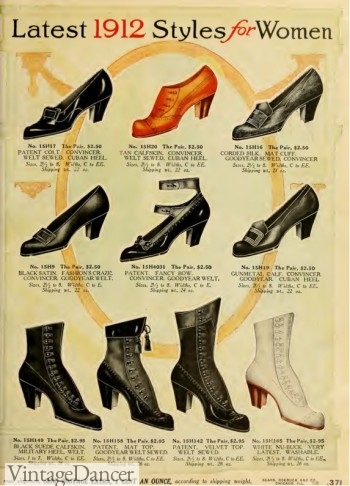
1912 ladies boots and shoes
DIY Titanic Dress Examples
These are a handful of other DIY Titanic dress costumes I have made. You can see how layering dresses, robes, shawls, and sashes can create an unlimited amount of Titanic era dresses.
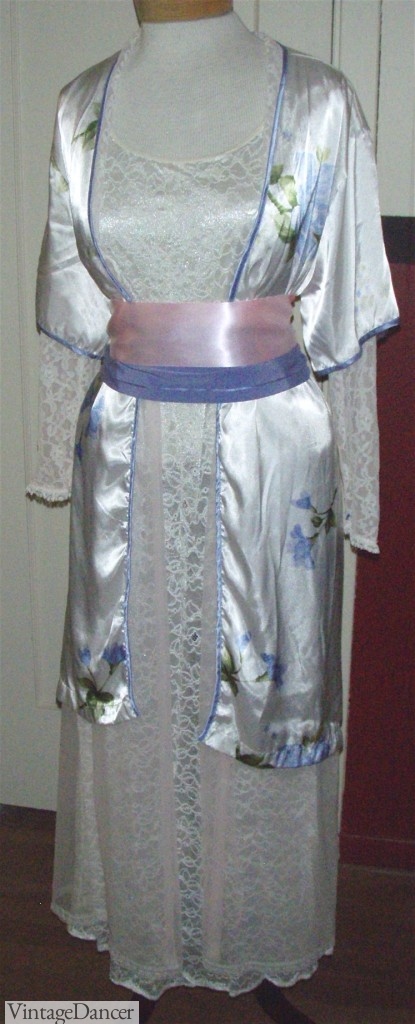
Layered Swim Dress- Floral robe over a chiffon robe and a lace slip with two sashes.
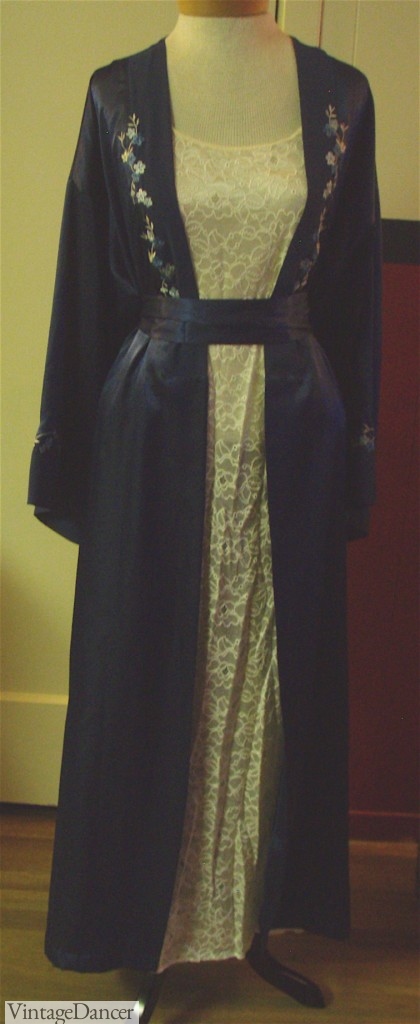
Dress Similar to Flying Dress- Silk embroidered robe over lace slip dress and skinny sash wrapped twice.
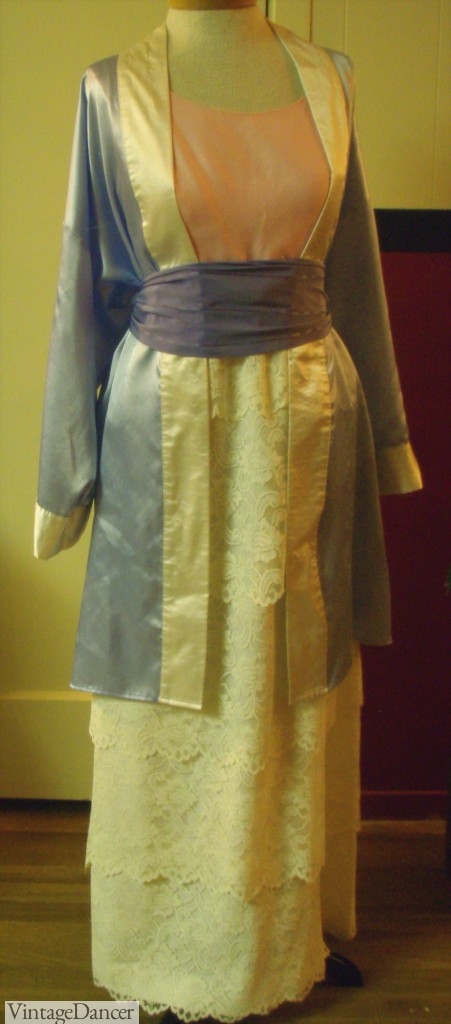
Blue and Pink Swim Dress- A robe over a 60s pink pink and lace dress with purple sash
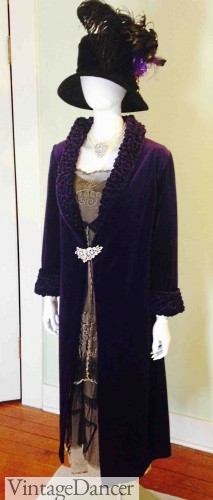
A rich purple velvet bath robe was the perfect coat to wear over my Nataya Titanic dress. The hat was a thrift store find as well with just a bunch of feathers added to one side.
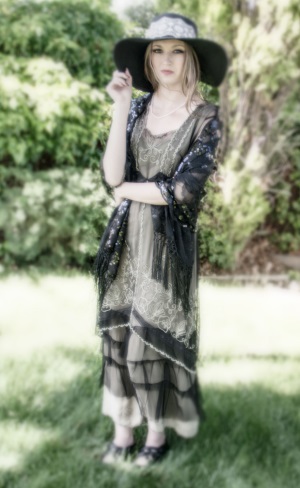
A slightly modern take on Titanic dress style using my Nataya Titanic dress, a fringe/beaded shawl, wide floppy hat.
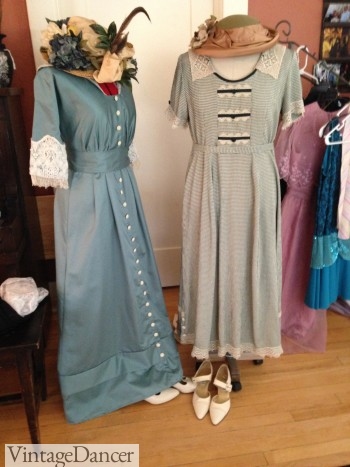
My friend’s two thrifty dresses. (L) A bed sheet was used to sew this dress from a 1910s pattern. (R) An ’80s prairie type dresses was trimmed with lace to give it a bit more 1910s day dress style. (Credit to Tina Davis-Hersey)
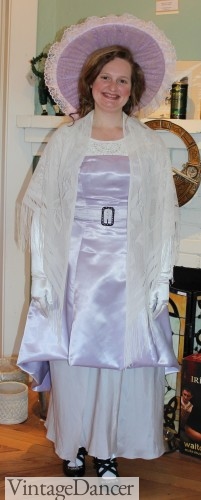
Thrifty creation. Two dresses layer together with one hemmed shorter to create an overdress
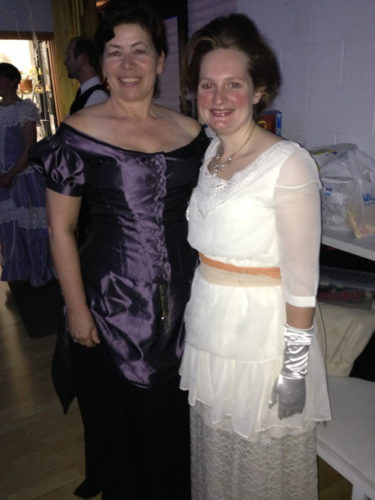
My white DIY Titanic Dress- Layering a short dress/long top over a long lace slip dress and adding a sash
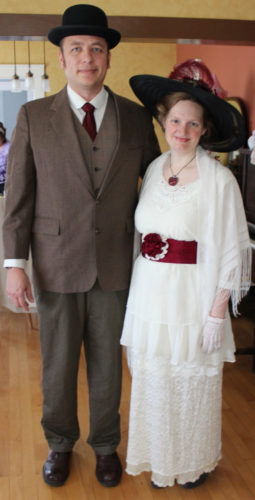
Again I used a lace slip dress layered with a a white tunic dress and a wide sash band with flower I made.
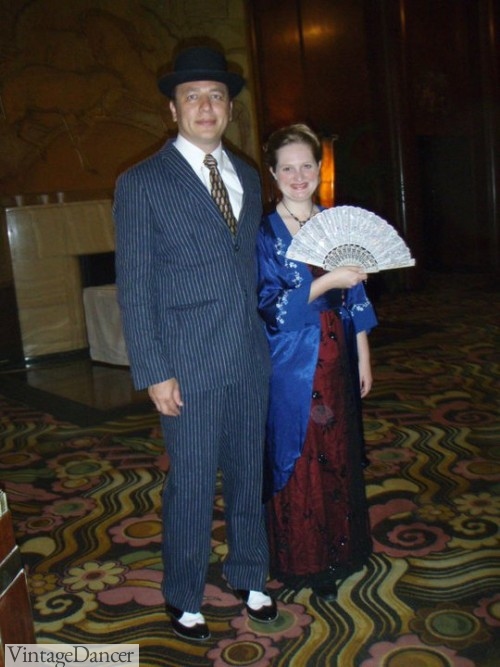
Red beaded dress (very similar to the Movie’s red dinner dress) with blue kimono coat and sash.
Another dress from one of my readers. I love it!
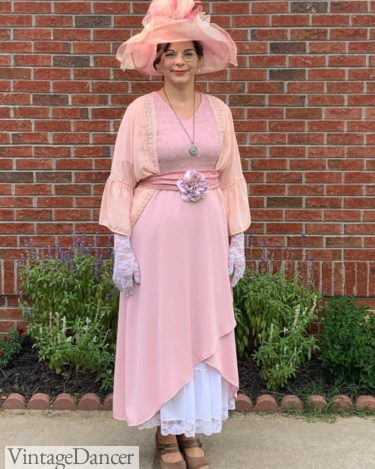
Holly M says: “The dress and the white skirt underneath it were thrift store finds. I had the kimono, scarf, and flower. I ordered the gloves and hat (which ended up matching the costume colors perfectly) from Amazon. “
Titanic Era Dress Examples
See examples of 1910s era dresses and learn the history of the time period:
1910s Evening Gowns and Dress History
Titanic Fashion & 1st Class Women’s Clothing
1910s Plus Size Fashion History
Edwardian Fabrics and Colors 1900-1919
Need help?
If you have any questions about making a dress, feel free to comment below or contact me.
Please, if you make a DIY Titanic dress for yourself, send me a picture! I would love to include more creations from our fans!
Debbie Sessions has been teaching fashion history and helping people dress for vintage themed events since 2009. She has turned a hobby into VintageDancer.com with hundreds of well researched articles and hand picked links to vintage inspired clothing online. She aims to make dressing accurately (or not) an affordable option for all. Oh, and she dances too.